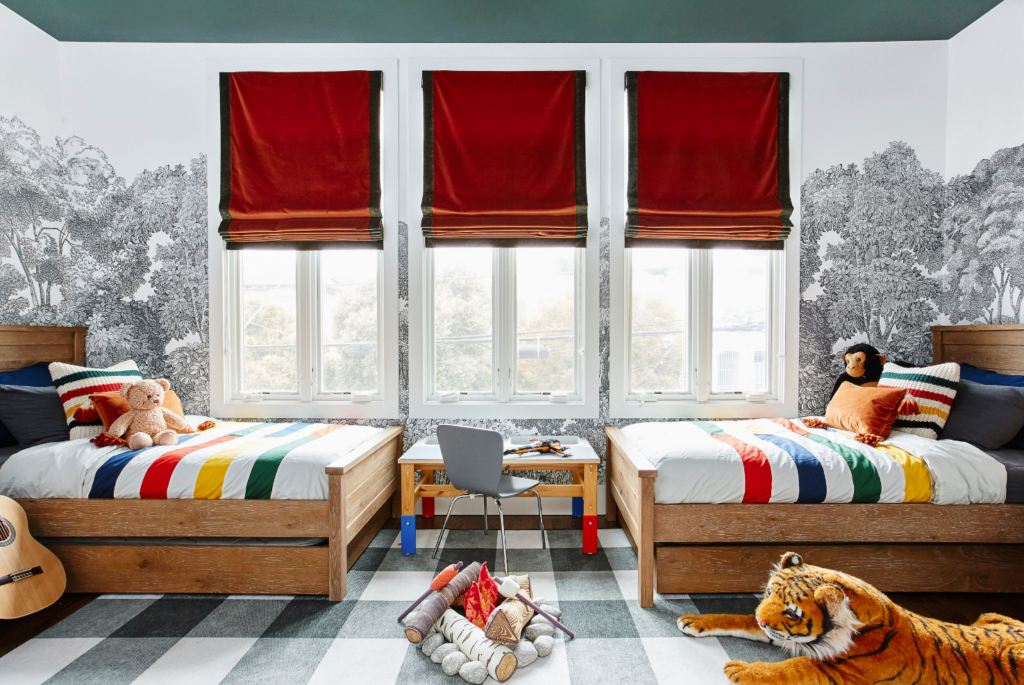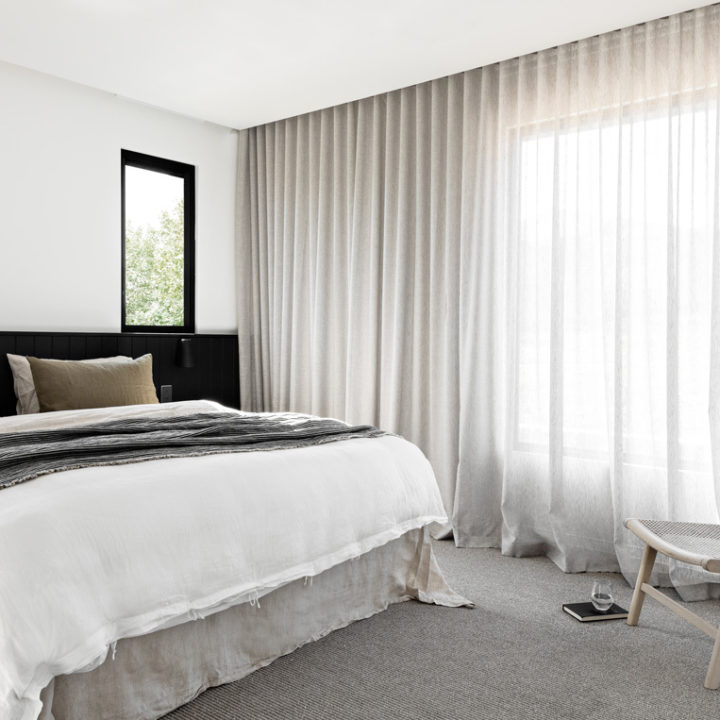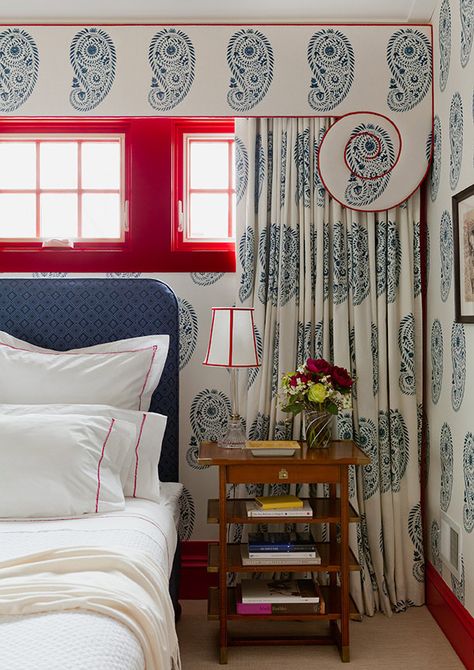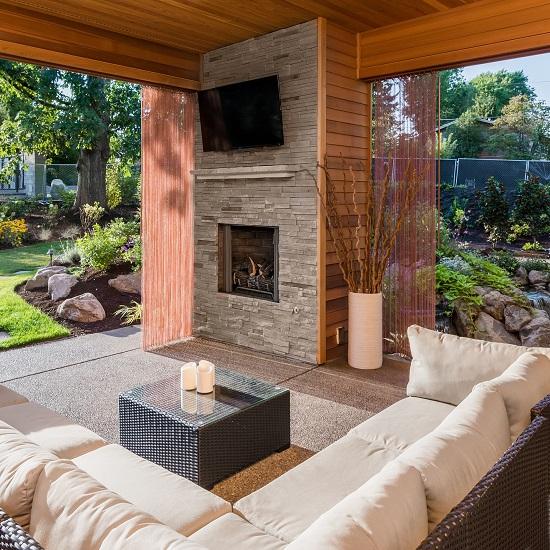Spiffy Speak
WHAT IS THE BEST FABRIC FOR ROMAN SHADES?

Home is our happy place and there’s no other like it on earth. Hence, when designing our home, we pay attention to the details, invest in solid research, and forage for the best and most durable materials. And while aiming at this target, we don’t want to miss our aesthetic goals. If while dressing your home’s windows, you’re looking for a modern, sleek option that looks truly bespoke, roman shades will be more than gratifying. And if you’re looking for advice on ‘what is the best fabric for roman shades?’, you’ll find your answer in this blog.
Order custom roman shades from Spiffy Spools online in any size. With over 3,000 fabrics to choose from, you are sure to find the perfect match for your room. At Spiffy Spools, you can find the perfect match for your window dressing for all decor styles and window sizes. So, whether you’re shopping for modern farmhouse window treatments or rustic roman shades for the kitchen in your country home or for decorating your log cabin, enjoy browsing through our vast collection and end your search with the most satisfying shopping cart check out with Spiffy Spools.
Characteristics that Make a Fabric Suitable for Roman Shades
Considering the way a roman shade functions is important to understand which fabrics are most suitable for constructing it. Roman shades are made up of a single panel of fabric stretched from end to end to fit the window in exact measures. When the cord is pulled, the shades form even folds and stack up at the top. This is why slats or dowels are used in most styles of roman shades to help them break into structured folds with a neat finish.
It is obvious that most roman shades would benefit from fabrics considered to be ‘drapery-weight’ fabrics, that are structured in the weave. The fabric should neither be so rigid that it won’t fold, nor so loosely woven that it won’t ‘remember’ the creases.
The fabric must ideally not be too heavy as that can contribute to the rigidity and difficulty of operation. But, it must also not be too light, or it can be too underwhelming for the structure. Lightweight fabrics can be compensated with lining, however, so that the folds are crisp and refined. Sheer fabric shades are an exception, of course, because if you back them with lining, you derail the motive of their transparency.
Yet another characteristic that a roman shade’s fabric should possess is non-stretchability. This is because the shades are created to fit with precision and are stitched with sharp angles. If the fabric is woven with a high degree of elasticity, it may affect the precision of measurements during stitching. And, in the course of time, the fabric will stretch with usage, exchanging its svelte silhouette for a droopy, lazy look.
So, ideally, the fabric that is used for roman shades must be such that it holds to the structure well and keeps the folds crisp and clean-cut. And, no matter which non-sheer fabric you select, lining the shade is highly recommended because it helps the face fabric retain its integrity. Besides, it adds volume and supplements both its aesthetics and its functionality. Sheers are, as noted above, an exception to this recommendation.
The Best Fabric for Roman Shades
We know now that for roman shades to function efficiently, fabrics that are non-stretchable, medium to heavy weight, tightly-woven and relatively thick are ideal. Other qualities one might desire are durability, color-fastness, breathability, and aesthetic appeal.
Of all the available fabrics, the one which meets most of your requirements should get the selection. We will now take you on a tour of various fabrics and their salient features so that you may discern which of these suits your space.
Linen Roman Shades
If you like natural fabrics, linen ticks the first box straight away. It is breathable, durable, and very homely in its appeal. The slubs of this fabric – rendering it a somewhat wrinkled look – are its typical and unique characteristic which woos homeowners who are looking for a lived-in feel with their decor.
Additionally, it is great for filtering in light and air, which makes linen ideal for kitchens, bathrooms, and family living rooms.
Note that loosely woven linen might be more stretchy and therefore, less capable of maintaining the structure. Instead, consider linens with tighter weaves, like Marble linen roman shades from our collection, to get the best results.
SHOP NOW: LINEN ROMAN SHADES FROM SPIFFY SPOOLS
Cotton Roman Shades
Yet another gift of nature, cotton is breathable and durable like linen but heavier and more refined. Cotton does not wrinkle easily like linen and therefore, looks more finished. But it still exudes a very homely feel, making it a good candidate for formal and semi-formal rooms.
Take Yamini Madagascar roman shades from our cotton shades collection for example, that features the classic herringbone weave in rich ivory tones. With a raw, softly tactile feel, Madagascar feels like a modern take on cotton, so cozy and full of flavor.
SHOP NOW: COTTON ROMAN SHADES FROM SPIFFY SPOOLS
Polyester Roman Shades
High-quality polyester is another alternative very suitable for roman shades. It is sturdy, colorfast, and economical. It doesn’t wrinkle, dries fast, and is easy to maintain.
Pure polyester roman shades are low-duty options for bathrooms where moisture and wetness are indispensable. However, note that they trap smells as they are not breathable and therefore not top candidates for most kitchens.
When selecting polyester shades, avoid ultra-thin, synthetic-feel fabrics that lack texture and warmth in their visual appeal. This is advised with a view to having a fabric that holds well to the structure of the shade.
Take a look at Winter Oak Ikat roman shades to understand what that means – it is synthetic, but comes across as cotton because of its rich texture.
Cotton & Linen Blend Roman Shades
If you’re concerned about the non-natural traits of polyester and the crumpling of cotton and linen, consider blends that offer the best of both worlds. They are more sturdy, refined, colorfast, and less moisture-wicking than pure cotton and linen. Hence, they are practically more efficient and easier to maintain.
Aztec cotton blend roman shades and Summer Dessert linen blend roman shades are examples of how a healthy mix of natural and non-natural yarns works well to create a cozy window treatment.
Silk Roman Shades
If you’re looking for a natural fabric for a formal setup, silk is the go-to. Unlike cotton and linen, it is lustrous, dressy, and one of the first options for formal living rooms, dining rooms, guest rooms, and bedrooms.
Pure silk is sensitive to intense light, heat and moisture. So ensure lining for your shade to reduce sun damage as much as possible and keep away from wet areas. Also bear in mind that silk retains water stains, making it the last candidate for bathrooms and kitchens.
If you love the idea of pure silk shades but shrug at their maintenance issues, go for faux silk shades instead. Get the killing looks, minus the qualms. June Day – from our faux silk collections – is a fine example of how you can bank on the sumptuous sheen of silk while keeping it practically efficient too.
SHOP NOW: SILK ROMAN SHADES FROM SPIFFY SPOOLS
Velvet Roman Shades
Velvet’s plush naps make it uniquely tactile and subtly lustrous – a favored option thereby for formal decor. Pilling is an issue that you’d have to be prepared for, but with regular vacuum cleaning schedules, it is good to go. And for that stunning look and luxe vibe, that’s quite a small price! Velvet is a heavy fabric and you might do well to avoid velvet shades for large windows to enjoy maximum functionality.
SHOP NOW: VELVET ROMAN SHADES FROM SPIFFY SPOOLS
How to Select Best Fabric for Roman Shades
As noted above, there are various kinds of fabrics available for roman shades. And, what’s the best one for you very much depends on a combination of different factors. For convenience, we have listed them for you as follows:
BREATHABILITY
In small and enclosed areas like bathrooms, laundry rooms and tiny apartments, it is important to look for fabrics that allow air circulation even when they are pulled down for privacy. Otherwise, the space may tend to become claustrophobic and suffocating. So, linen, cotton and their blends work best here. In bathrooms and enclosed kitchens, blends may do better which allow breathability but also uphold the fabric structure longer despite exposure to moisture. They often also dry faster when exposed to accidental splashes.
FORMAL VS .CASUAL SETUP
In formal spaces like living and dining rooms, high-end fabrics like velvets, silks and faux silk are best to keep up with the duty of impressing guests. Also, private rooms like bedrooms and guest rooms – if decorated formally – benefit from their dressy looks. Whereas in a space arranged to feel laidback, cotton, linen, and their blends are the best choice for roman shades.
EXPOSURE TO WATER AND MOISTURE
Go for medium-weight, fast-drying fabrics for kitchen roman shades and bathroom roman shades where the shades will be exposed continuously to water and moisture. So, avoid velvet shades because they are heavy and non-breathable, and silk shades because they are unforgiving to water stains. Loose-woven linen, cotton, and blends suit these spaces as they are breathable, durable, fast-drying, and casual in appeal.
SIZE OF WINDOW/ FREQUENCY OF USAGE
Extremely heavy shades will be difficult to operate. So, go for multiple panels for an over-wide window if you intend to operate the shades fairly regularly. For big windows, avoid heavy fabrics as the functional efficiency of these shades may be compromised, especially if you’re lining them.
CONSIDER THE STYLE
Shades that are structured with slats are easy to operate as they can form folds easily. The fabric composition of these shades can range from lightweight to heavyweight. But, for the relaxed shades which are constructed without slats, we advise medium-heavy fabrics only as these serve better to form the swagging, curved bottoms.
How to Select the Lining
The lining of the shade serves to support accuracy in measurements by adding to the volume, thus, creating a finished look. It also provides more privacy and protects the face fabric from sun damage and easy fraying from usage. Furthermore, the lining accentuates the insulative and acoustic capacity of the roman shade.
That said, avoid lining sheer shades because that totally defeats the purpose of selecting a sheer fabric in the first place. Also bear in mind that certain styles of roman shades like the back-slatted shades cannot be constructed without lining. So, if you choose sheer or semi-sheer fabrics, choose the front-slatted style or relaxed styles that can be constructed without lining.
When choosing lined roman shades, always take into account its rear-side view. This is an unskippable step, especially if the windows or doors open to other rooms. So, your shade will look like a solid neutral shade from the other side of the window.
At Spiffy Spools, you can choose from two types of linings for your roman shades – privacy lining and blackout lining.
PRIVACY LINING
It is a standard white fabric that adds volume to the shade and protects the face fabric from weathering due to continuous exposure to sunlight. It also helps the shade remain more structured and crisp – a big help for lightweight fabrics to have a better performance as well as aesthetic appeal.
BLACKOUT LINING
Available in pale beige and light gray, blackout lining is a relatively thicker, chemically treated fabric. It blocks out light, muffles sound, and retains thermal energy in the room. So, it is a great option for bedrooms and rooms that are exposed to extreme sunlight. On cold winter nights, it can save you some energy spent on heating too. We, therefore, highly recommend a blackout lining for room darkening in bedrooms, nurseries and media rooms.
READ MORE: CHOOSING LINING FOR WINDOW TREATMENTS
Final Words
So, you now have all the information in hand to make one of the most important decisions when shopping for your roman shades. At Spiffy Spools, you have no dearth of variety whether with regard to color, pattern, or texture. And, you have various styles of roman shades to choose from to suit varied decor styles and specific needs. So, browse our collections and find the perfect window treatment for your space today.
READ MORE: WHAT ARE ROMAN SHADES: A COMPLETE GUIDE














